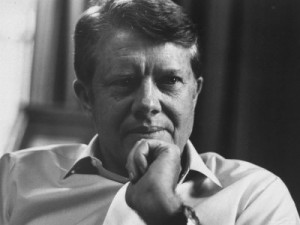1.
In his 2007 book Palestine Peace Not Apartheid, former U.S. president Jimmy Carter had this to say: “When we arrived there in January 1996, it was obvious that the Israelis had almost complete control over every aspect of political, military, and economic existence of the Palestinians within the West Bank and Gaza.” It’s good to say what you see. It’s even better to see what you see.
2.
Later, Jimmy Carter even went to Bil’in where the local Palestinians have protested weekly for years against the separation wall Israel has been building. They’ve been joined by internationals and Israeli dissidents. The people of Bil’in embody sumud—“steadfastness.” Willfully blind nay-sayers ask, “Where are the Palestinians Gandhis?” Those critics would see plenty of the “Gandhis” in Bil’in and many other villages of the West Bank if they would go there, as Jimmy Carter did.
3.
When he was governor of Georgia in March 1971, Jimmy Carter celebrated an “American Fighting Men’s Day.” On that day he urged the state’s citizens to be in solidarity with one of Georgia’s own and so to drive with their headlights on “to honor the flag as ‘Rusty’ had done.” “Rusty” was Lieutenant William Calley then under house arrest at Fort Benning; he was facing charges for murdering over 100 “Orientals” in the Vietnamese village of My Lai on 16 March 1968.
4.
In 1977, the first year of his presidency, Jimmy Carter was asked at a press conference if the U.S. should pay reparations to the Vietnamese. He responded, “The destruction was mutual. We went to Vietnam without any desire to capture territory or impose American will on other people. I don’t feel that we ought to apologize or castigate ourselves or to assume the status of culpability.”
5.
When he was long out of the Oval Office, Jimmy Carter could be elbow to elbow with the Palestinian Gandhis, who are still seen as terrorists by the Israeli state that seeks their disempowerment and dispossession. In his mid-eighties now, Carter could conceivably take a flight to Southeast Asia. It could be arranged for him to meet people over age fifty who survived My Lai. They could tell him a thing or two about how Rusty Calley and Charlie Company honored the flag. Carter and his esteemed elders could make a pilgrimage to many villages throughout southern Vietnam, so many of which received similar treatment from the U.S. armed forces, albeit on a smaller scale. And the Vietnamese could tell Carter enough stories to give him nightmares for the rest of his life, those nightmares being the distant consequences of his predecessors’ policies in the Oval Office, policies over which we ought not castigate ourselves.
6.
On another trip to Vietnam, Jimmy Carter could spend some time with some of the young and aged Vietnamese victims of U.S. chemical warfare (Agent Orange, provided by Dow Chemical and Monsanto, among others). He could explain to them how the U.S. owes them nothing.
